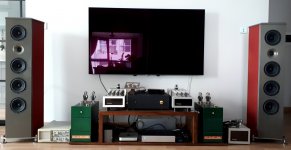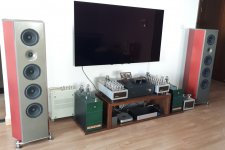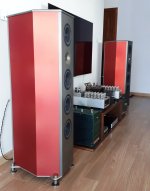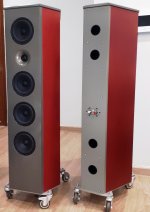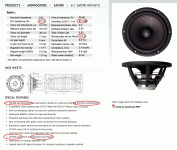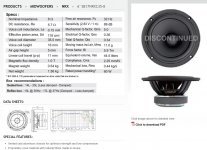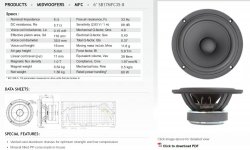This is my Elsinore speaker Mk6 SE version. My speaker version using the woofer Satori MW16P-8 and tweeter Satori TW29RN. However, the biggest different with the Mk6 is the enclosure. My speaker enclosure are made by aluminium & stainless steel. It's shape also quite abnormal to make sense of different. All of these material make my speaker extremly heavy, the final weight is 125 kg.
The sound from speaker quite impressive. The speakers sound is clean, open in vertical and horizon, deep in sound stage and I think it sound no coloring any band.
Thank alot for Joe
The sound from speaker quite impressive. The speakers sound is clean, open in vertical and horizon, deep in sound stage and I think it sound no coloring any band.
Thank alot for Joe
Attachments
This is my Elsinore speaker Mk6 SE version. My speaker version using the woofer Satori MW16P-8...
I am looking at the driver that would work best with the existing box and this one you are using, MW16P-8, definitely comes close. But it will need to be tuned to a lower frequency and the vent increased in length, up to 130mm long.
The downside is that the speaker will be 1.5dB less sensitive, going by their figure for voltage sensitivity.This usually means more heat too, but I can see that the Re is higher by a bit, that helps, also look at the openness of the construction, it is designed to get rid of heat better than the SB17 we are currently using. Low heat in the voice coil is a big part of the design, but this is probably about equal.
How expensive were they? Double?
Also, with Sartori drivers, maybe we should give it a name, like Elsinore Mk7 Pro.
Joe
I am looking at the driver that would work best with the existing box and this one you are using, MW16P-8, definitely comes close. But it will need to be tuned to a lower frequency and the vent increased in length, up to 130mm long.
The downside is that the speaker will be 1.5dB less sensitive, going by their figure for voltage sensitivity.This usually means more heat too, but I can see that the Re is higher by a bit, that helps, also look at the openness of the construction, it is designed to get rid of heat better than the SB17 we are currently using. Low heat in the voice coil is a big part of the design, but this is probably about equal.
How expensive were they? Double?
Also, with Sartori drivers, maybe we should give it a name, like Elsinore Mk7 Pro.
Joe
I tuned at 31Hz by using 4 vent of diameter 63mm with 200mm long.
Expense for the enclosure much more compare to drivers and crossover part
Attachments
One using drivers suited to a sealed box would be good.
For a number of reasons I can't see that happening. It's about what is available driver wise and the requirements being met.
I am taking a bit more interest in the Sartori MW16P-8 and the only slight downsides are the lower sensitivity, this is due to Re being 6.2R an where it was 5.7R aand the slightly higher cone mass 12.4g up from 11g.
Note where it says "low compression" and "reduced compression" and "vented aerodynamic" - I have no doubt this is a reference the thermal compression. From the beginning, this was always a big consideration from the first Elsinore speaker when it was first conceived back in 2004, running the voice coils much cooler than usual. But it is interesting that heat and compression are clearly associated/connected in their minds too.
Has anybody noticed that the Elsinores are effortlessly dynamic? That's why!
Interestingly, line source speakers also run very cool internally. So there is an influence of line source influencing Elsinore development.
The other thing that I can see is that the radiation pattern, going on their measurement, is more consistent, the on axis is smoother and less elevated above 2KHz, 30 degrees of axis near on par, perhaps Sartori slightly better, but 60 degrees the Sartori wins hands down.
So....?
It won't be a rush, but perhaps in 2019 there could be a Mk7 'Pro' - but it will clearly be costlier. The tweeter and waveguide will be the same. The box will be the same, but the diameter of the driver is different, the Sartori being slightly smaller. The crossover will of course be different, but perhaps not by a large degree, but definitely some values will need to be changed. I can see that 1.5uF will be needed instead of 1.8uF for the tweeter. The box will also need a longer port as we need to tune down to 31-32 Hertz.
Now what is the price difference between the drivers?
Edit: Just checked locally and AUD $60 for SB17 driver and AUD $149 for MW16P-8.
.
Note where it says "low compression" and "reduced compression" and "vented aerodynamic" - I have no doubt this is a reference the thermal compression. From the beginning, this was always a big consideration from the first Elsinore speaker when it was first conceived back in 2004, running the voice coils much cooler than usual. But it is interesting that heat and compression are clearly associated/connected in their minds too.
Has anybody noticed that the Elsinores are effortlessly dynamic? That's why!
Interestingly, line source speakers also run very cool internally. So there is an influence of line source influencing Elsinore development.
The other thing that I can see is that the radiation pattern, going on their measurement, is more consistent, the on axis is smoother and less elevated above 2KHz, 30 degrees of axis near on par, perhaps Sartori slightly better, but 60 degrees the Sartori wins hands down.
So....?
It won't be a rush, but perhaps in 2019 there could be a Mk7 'Pro' - but it will clearly be costlier. The tweeter and waveguide will be the same. The box will be the same, but the diameter of the driver is different, the Sartori being slightly smaller. The crossover will of course be different, but perhaps not by a large degree, but definitely some values will need to be changed. I can see that 1.5uF will be needed instead of 1.8uF for the tweeter. The box will also need a longer port as we need to tune down to 31-32 Hertz.
Now what is the price difference between the drivers?
Edit: Just checked locally and AUD $60 for SB17 driver and AUD $149 for MW16P-8.
.
Attachments
Last edited:
What about the SB17CRC35-8?
I think the Satori drivers are too expensive. Not a lot of people would build your design. And that's a shame.
Sorry for the delay, been considering things re finding a replacement, but SB17CRC35-8 is not the one. A drop of 2dB is just a bit too much and due to cone being heavy at 13.3gr - but I have this one in mind:
SB17MFC35-8
This only has a 1dB drop and that is the same as Peerless Nomex HDS driver.
I would prefer a fibre cone, definitely not so much metal and ceramic cones, but the SB19MFC35-8 is a mineral loaded PP cone. Interestingly, the motor system is the same and the PP driver version is a bit more expensive than the fibre cone we have been using - this means that the mineral loaded PP cone is more expensive to make and that is reflected in the price.
I have attached both fibre and PP cone versions specs below, if anything, the response above the 'knee' of the driver (the frequency when the driver stops working as a piston) looks smoother according to SB's plot.
The 1dB lower sensitivity should mean that the sensitivity is still somewhat above 90dB. The voice coil will run 20-25% warmer, but so was the Peerless HDS and so not too bad.
Since coil and motor system is the same, has the same low rated inductance of 0.15mH, I see little need for change in the crossover, the only one would be an increase on the series resistor on the tweeter, it is 2R and I would increase to 3R or 3R2 - and that should be it.
For the last 10 months I have been working on a 'discussion paper' that explains the thinking behind the Elsinore speakers, but it is quite large and around 70 pages (may try reduce that). The emphasis is keeping an eye on what the current does and that the back-EMF that makes a driver 'reactive' can only be reactive if the amplifier produces reactive current. It has been a massive effort to write this and one day this version or a simpler version will be posted online. But these days you have to be careful as if anybody either misunderstands it and find something wrong with it (even if it is only their misunderstanding) and you get trolled for no good reasons. A previous attempt to have an online discussion on this just got trolled. It is a sign of the times we live in.
But I only mention this because the change only needs to be a single resistor value. For two reasons, electrically the drivers are the same and the crossover here is based on "what does the current do." For this reason, the Elsinore only uses a single inductor on both low pass filters. This 0.47mH inductor on the top two drivers is three times the internal more non-linear 0.15mH, so the amplifier sees most the much larger external and cleaner inductance of the external inductance, because they are in series, it also pushes up the impedance the amplifier sees, and that makes it easier to equalise the current that the amplifier sees. The whole point here is that the amplifier produces the same current at all frequencies and also keeps the current phase angle of the amplifier low and near zero degree phase angle. This total arrangement suppresses reactive current to the back-EMF impedance of the driver. So even if the response is not totally the same with the new driver, the deviation will still be small, but my priority is that what the current does.
So that gives you just a little insight into what the Elsinores do. Build them and enjoy them, but know that behind the obvious, there are things less obvious.
So take a look at the two drivers below.
Cheers, Joe
.
Attachments
Just a few more notes on the differences between drivers. The both use the same motor system, so the cone is what sets them apart. The key here is the difference in mass, our original driver is 11.0gr and the new 11.8gr. That would explain the 1dB difference in output, 89dB reduced to 88dB because of the higher cone mass. The other difference is a slight increase in Qes, which means slightly less electrical damping, but mechanical damping not changed. The slightly lower Vas offsets it. The Fs has barely changed.
Bottom line: The driver will work in the same box alignment with very little change, keep the port 100mm long. Build the box exactly the same way as before.
Mineral loaded cones are used by Dynaudio drivers, and very good results, this is not going to be a bad driver going ahead. It is just a little bit more expensive, but not by that much.
There is no reason to stop making Elsinore Mk6 speakers!
.
Bottom line: The driver will work in the same box alignment with very little change, keep the port 100mm long. Build the box exactly the same way as before.
Mineral loaded cones are used by Dynaudio drivers, and very good results, this is not going to be a bad driver going ahead. It is just a little bit more expensive, but not by that much.
There is no reason to stop making Elsinore Mk6 speakers!
.
Last edited:
'discussion paper' that explains the thinking behind the Elsinore speakers, but it is quite large and around 70 pages
That is more a small book than a “paper”.
dave
Not so sure about the poly cones though.They tend to sound a bit dull and very often woolly.I have owned Dynaudios [contour 1.3 mk 2s] and after while you realise that is how they sound.Even the Harbeths and Spendors can sound a bit that way.By no means bad but there is a definite poly cone tonal signature.Paper based drivers sounds more natural to me.
...I have owned Dynaudios... Even the Harbeths and Spendors can sound a bit that way.By no means bad but there is a definite poly cone tonal signature.Paper based drivers sounds more natural to me.
I tend to agree with you, I prefer some kind of fibre driver too. But (and I hate the word) the voicing of Dynaudio and Harbeths also seems to be contributing to their particular sound. To me it is about getting the speaker sounding right, even accurate (a word that can be misunderstood as well). For example, some speaker designers literally will voice their speaker on... you guessed it... pretty much with recording of voices. I think Harbeth might be in that camp.
Also, the Elsinores runs incredibly cool voice coils. if a single driver required 1 Watt to produce 90dB-SPL, that means pretty much 99+% of heat dissipated by the voice coil. With the Elsinores, producing 90dB-SPL, the voice coil in the individual driver is under 100mW. That translates into effortless dynamics, not like most boring 2-Way designs that just can't cut it. They just don't have that sense of life in the music. Just ask the other Elsinore builders about that.
That is more a small book than a “paper”.
dave
Hi Dave
A copy is on its way to you shortly - as you already knew, you are on the list.
I had a physicist (and speaker designer, once with a prestigious company) check it out, especially to see that the major arguments and numbers are on the money. He found nothing wrong. This is important in Part One, the theoretical part (out of three), as it describes an equivalence test, which when a driver is tested with both current and voltage sources, shows that the difference in dB-SPL (needs a mic of course) is caused by the back-EMF of the driver, and that the back-EMF of the driver is an actual impedance with a value in Ohm. He passed it and it is sound - and that is what everything rests on. So very pleased.
Cheers, Joe
Just a few more notes on the differences between drivers. The both use the same motor system, so the cone is what sets them apart. The key here is the difference in mass, our original driver is 11.0gr and the new 11.8gr. That would explain the 1dB difference in output, 89dB reduced to 88dB because of the higher cone mass. The other difference is a slight increase in Qes, which means slightly less electrical damping, but mechanical damping not changed. The slightly lower Vas offsets it. The Fs has barely changed.
Bottom line: The driver will work in the same box alignment with very little change, keep the port 100mm long. Build the box exactly the same way as before.
Mineral loaded cones are used by Dynaudio drivers, and very good results, this is not going to be a bad driver going ahead. It is just a little bit more expensive, but not by that much.
There is no reason to stop making Elsinore Mk6 speakers!
.
So should we race out and buy up some spares of the original SB drivers before they run out or will the newer ones mentioned be as good or maybe better?
Cheers.
So should we race out and buy up some spares of the original SB drivers before they run out or will the newer ones mentioned be as good or maybe better?
Cheers.
I would still get the original SB driver while it is available, as it is still preferable. But the new SB SB17MFC35-8 driver is still good enough so that the EL-6 will still be worth it for those who miss out on the original drivers.
Does anybody have any still any SSB17NRXC35-8 drivers available in Australia?
Cheers, Joe
Not sure about Australia but in EU they are still available. Bought 8 pieces last week without any problem.
Regards,
Yes, I have noted, but the cost to send to Australia is prohibitive. There would be larger pockets of stock in EU and perhaps US too. So I recommend those who can, get in now. But the replacement driver won't be so bad that they are not worth using when current driver truly runs out everywhere.
Cheers, Joe
Tried WES components in Sydney today but listed as NLA. They have the NRX2 listed as the replacement but clearly it isn't. It's a pity we didn't get wind of the discontinuation of the NRX before stocks dried up. The Peerles Nomex drivers are still readily available. (Bought a spare just in case they dry up too). Very happy with my MKV's.
Tried WES components in Sydney today but listed as NLA....
I know, because I bought the last ten they had for a friend.
Greetings from Copenhagen, Denmark.
- Home
- Loudspeakers
- Multi-Way
- The "Elsinore Project" Thread
